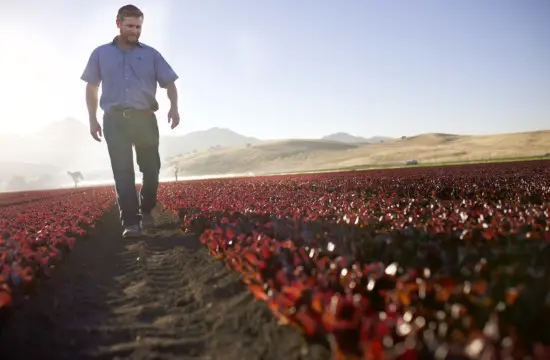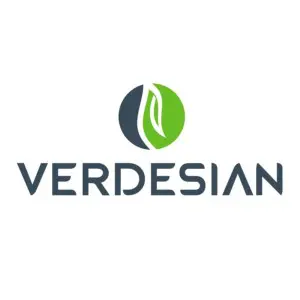Brent McKinsey is a third-generation grower in Central California. His family’s growing and shipping operation, Mission Ranches, produces leafy greens, lettuce, spring mix, cauliflower and celery using both organic and conventional farming methods at their three locations in western Arizona, and central and southern California. There are many challenges that come along with being a grower in California – especially regarding water management, but Brent finds ways to utilize his land and his inputs in a way that benefits his operation financially, while also having a positive effect on the land.
What is your typical crop rotation, and what does an average growing season look like to you?
The unique thing about being in the vegetable industry is, traditionally, the land value is very expensive where we are located. Because of this, we have to put a minimum of two to three crops in per field. So, we have a really tight growing schedule – we’ve got to work our ground and turn our ground to be able to sustain so many different crops.
What are some of the challenges you face when producing multiple crops?
We’re not only dealing with multiple crops, we’re dealing with different times of the year. So sometimes, we’re irrigating a lot more, and sometimes we’re just trying to figure out how we’re going to get in to work the ground because it’s wet. One of the main challenges is managing a planting schedule and determining how much of each commodity to grow so we know we have the space and the growing environment for each. The Mission Ranches Salinas Valley operation is about 100 miles from north to south, so there is a different microclimate that we utilize throughout the growing season to be more sustainable, especially in our organic program.
What is your typical nutrient management plan for your crops?
Most of our crops require about 85 to 185 units of nitrogen, and we typically split that over three sidedress applications. The first sidedress will happen in the first 14 days of the crop, the second will occur by the 30 day mark, and a third smaller fertigation if needed, will happen around day 50.
What are you doing on your operation to maximize nutrient efficiency?
We do our best to conserve fertilizer. We’ve always been in a market-based industry, so we have to put on what the crop needs to produce the best crop we can, but we also utilize our crop rotation to maximize nutrient availability in the soil. By growing different vegetables, we can build up the supply of those key nutrients in the soil to be there when the crops need them.
Are some crops more beneficial from a nutrient management standpoint, and if so, which ones?
We use broccoli a lot for rotation. It’s not the highest paying crop but cleans the ground up and pulls nitrogen so it’s available for the next crop. Snap peas are only in the ground for around sixty-five days, but it’s really good in the crop rotation because it’s an excellent for nitrogen fixation, so it keeps a lot of that N in place for when the next crop needs it.
What practices are you implementing to ensure your applied nutrients make it into the crop and not into nearby bodies of water via runoff?
Well, since we use managed irrigation, that definitely helps us control the amount of water we’re using to make sure we’re not over irrigating or under irrigating. We try not to irrigate as much to avoid runoff. We really know our soils and our fields, which helps us control over-irrigation and in turn, control our water and reduce nitrogen runoff and leaching.
What is the biggest challenge you face on your operation?
The last six years we’ve been in a very tough drought. Being in Central California, located in part of the Salinas Valley, right now groundwater is our only source of water. So, we do our best to manage how we pump our water and try not to over drought our aquifer.
Since you’re in an area that often faces droughts, tell us about how you manage water availability.
For most of our water, we use sprinklers and a little bit of drip tape, depending on the crops. Here in the western part of California, there is very little rain, so for a majority of the crops we grow here we pump up the groundwater and use that to irrigate the crops. Depending on where the crop is in the growing cycle, we water anywhere from one day a week to three or four times a week.
How do you approach working with your PCA when determining your nutrient management plan?
Our PCAs help us with a lot of things, both on the chemical side, spraying the applications and also on the fertilizer side. Since our PCAs not only walk our fields but other growers’ in the region, they are able to look at other crops in the area and see what’s happening in those crops and compare them to ours to help us make decisions. For example, our soil type in the area is one that leaches nutrients fast, so if there is more rain, they suggest we put on slow release nitrogen to better suit our needs.
What are you adopting or implementing across your ranches to improve sustainability and conserve resources?
I think farmers are the original sustainers of the land. We make our living off of the land, so we’re going to make sure we’re conserving nature and resources so we can continue farming. On our ranches, we’re also organic farmers, and we’re the first people in this area to really start farming organically on the commercial level. But not just that – we pass these ranches down through the generations, and what we put down now affects the future of this ranch. We don’t want to be a detriment to our own future.
Most California growers see value in taking the initiative upfront to protect our natural resources and improve the efficiency of their inputs. Brent McKinsey is among those growers, and he’s helping to ensure that a majority of what Mission Ranches farms and puts into the land goes into their crops and isn’t left behind unused or lost to the environment.


